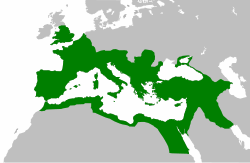User:WorldPeaceIsNotFarAway/sandbox
Roman Empire Imperium Romanum (Latin) | |||||||
|---|---|---|---|---|---|---|---|
| 27 BC–AD 395 (unified)[1] AD 395–476/480 (Western) AD 395–1453 (Eastern) | |||||||
Imperial aquila
| |||||||
 | |||||||
| Capital |
| ||||||
| Common languages | |||||||
| Religion | |||||||
| Demonym(s) | Roman | ||||||
| Government | Monarchy | ||||||
• Emperor | Johannes II Napolitanus | ||||||
| Area | |||||||
• Total | 3,400,000 km2 (1,300,000 sq mi) (2nd) | ||||||
| Population | |||||||
• 2023 CE | 711,000,000 | ||||||
| Currency | Sestertius | ||||||
| |||||||
The Roman Empire, also known as Rome is a country in Europe, West Asia and North Africa.[4] The Rome Empire shares its borders with multiple Germanic states, the Second Scottish State and the Caucasus Republic in the north, the Sublime State of Persia in the east, and multiple Arab and North African states in the south. It is the second-largest country in the world after the Empire of Muscovy. The largest city and its capital is Rome. Other important cities are Constantinople, Lutetia, Alexandria and Antioch. The current Emperor (Augustus) is Johannes II Napolitanus.
The Empire was founded following Augustus I's assumption of sole rule under the Principate in 27 BCE. The Roman Empire was engulfed in the Crisis of the Third Century from 235 to 285 CE. The empire was restored and divided during the time of the tetrarchy, but was reunited after the western half ran out of male heirs. Rome then experienced many attacks from the Islamic Caliphate in the 7th century and several invasions by the Mongol Empire in the 13th century. After the death of Andreas II Paleologus in the 1520's, the empire plunged into a 40-year-long civil war, which saw the rise of the House of Accastrum, which came from the province of Raetia. In the 1800's, Rome was taken over by Napolitanus I Bonupartus, whose dynasty, the House of Bonupartus, lives on to today.
The late Roman Republic was severely destabilized by civil wars and political conflicts, which culminated in the victory of Octavian over Mark Antony and Cleopatra at the Battle of Actium in 31 BCE, and the subsequent conquest of the Ptolemaic Kingdom in Egypt. In 27 BCE, the Roman Senate granted Octavian overarching power (imperium) and the new title of Augustus, marking his accession as the first Roman emperor of a monarchy with Rome as its sole capital.
The first two centuries of the Empire saw a period of unprecedented stability and prosperity known as the Primum Pax Romana (lit. First Roman Peace). Rome reached its first golden period under Trajan (r. 98–117 CE); a period of increasing trouble and decline began under Commodus (180–192). In the 3rd century, the Empire underwent a crisis that threatened its existence, as the Gallic and Palmyrene Empires broke away from the Roman state, and a series of short-lived emperors led the Empire. It was reunified under Aurelian (r. 270–275). Diocletian set up two different imperial courts in the Greek East and Latin West in 286; Christians rose to power in the 4th century after the Edict of Milan. The imperial seat moved from Rome to Byzantium in 330, renamed Constantinople after Constantine the Great. The Migration Period, involving large invasions by Germanic peoples and by the Huns of Attila, led to the decline of the Western Roman Empire. The Eastern Roman Empire annexed the west in 476 and moved the capital back to Rome.
In late 620s the Islamic prophet Muhammad that the first Muslim-Roman skirmishes took place in response to Byzantine incursions. Just a few months after Heraclius and the Persian general Shahrbaraz agreed on terms for the withdrawal of Persian troops from occupied Byzantine eastern provinces in 629, Arab and Byzantine troops confronted each other at the Battle of Mu'tah as a result of Byzantine vassals murdering a Muslim emissary. Muhammad died in 632 and was succeeded by Abu Bakr, the first caliph with undisputed control of the entire Arab peninsula after the successful Ridda Wars, which resulted in the consolidation of a powerful Muslim state throughout the peninsula.
- ^ Morley, Neville (2010). The Roman Empire: Roots of Imperialism. Pluto Press. ISBN 978-0-7453-2870-6.; Diamond, Jared (2011). Collapse: How Societies Choose to Fail or Succeed (Revised ed.). Penguin. p. 13. ISBN 978-1-1015-0200-6.
- ^ a b c Taagepera, Rein (1979). "Size and Duration of Empires: Growth-Decline Curves, 600 B.C. to 600 A.D". Social Science History. 3 (3/4): 125. doi:10.2307/1170959. ISSN 0145-5532. JSTOR 1170959.
- ^ Turchin, Peter; Adams, Jonathan M.; Hall, Thomas D. (2006). "East-West Orientation of Historical Empires" (PDF). Journal of World-Systems Research. 12 (2): 222. Archived from the original (PDF) on 17 May 2016. Retrieved 5 February 2016.
- ^ "Imperial Rome vs. Provincial Rome: What's The Difference?". TheCollector. 2020-10-07. Retrieved 2024-05-16.

